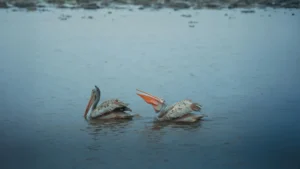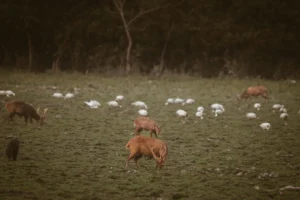Situated in the center of Assam, which seems like the heartbeat of Assam, Kaziranga National Park is a UNESCO World Heritage Site and a treasure trove of biodiversity. Known worldwide for its thriving population of the one-horned rhinoceros, this sanctuary offers an authentic Assam wildlife safari experience.
Whether you’re planning a Kaziranga National Park tour for a weekend or a detailed Kaziranga jungle tour, this guide covers everything from how to reach, what to see, where to stay, and how to plan your safari for an unforgettable adventure. It is intertwined with the Brahmaputra River, originating from the snowy reaches of Arunachal Pradesh during the monsoon. The river flows immensely, often causing floods that endanger wildlife like rhinos. In 2012, around 13 rhinos and several other animals perished in the floods; the forest Department constructed an elevated mud platform where animals can seek refuge during heavy rains and floods.

Table of Contents
ToggleHistory of Kaziranga National Park
Even during the British era, Kaziranga was renowned for its large rhinoceros population in 1904. The wife of the Indian Viceroy visited Kaziranga but could not spot a single rhinoceros due to the immense hunting. Upon her return, she urged her husband to prohibit rhino hunting, so on June 1st, 1905, Kaziranga was designated as a reserve forest with a ban on rhino hunting.
After India gained Independence, Kaziranga was declared a national park in 1974, with conservation efforts aimed at preserving its forest ecosystem. In 1985, Kaziranga earned the UNESCO World Heritage status, becoming one of India’s seven natural heritage sites. Additionally, Kasanga is a tiger reserve that received this designation in 2006. While rhinoceros sightings are common in kiranga spotting, Tigers are less frequent. This is not because of their scarcity but due to their hiding in the tall grasses. The central zone is where rare golden tigers have been observed during our slow drive through the forest

How to Reach Kaziranga National Park?
Kaziranga is located in the Golaghat and Nagaon districts of Assam and is easily reached by road, rail, and air. The park’s central location in northeastern India makes it well connected-with nearby cities like Guwahati, Jorhat, and Tezpur.
By Air
The nearest airport is Jorhat Airport (Rowriah Airport), about 97 km from the park. Alternatively, Lokpriya Gopinath Bordoloi International Airport in Guwahati is approximately 217 km away and has better connectivity with major cities like Delhi, Kolkata, and Mumbai. Taxis and buses are available from either airport in Kaziranga.
By Train
Furkating Railway Station, 75 km from Kaziranga, is the closest railhead. It’s well-linked to Guwahati, Dibrugarh, and other major Assam cities. From Furkating, taxis, and local buses take you to the park.
By Road
Kaziranga is well-connected by National Highway 37 (NH37). State transport buses, private coaches, and taxis regularly ply between Guwahati, Tezpur, Jorhat, and Kaziranga. For a comfortable journey, book a cab or hire a car for the 4-5 hour drive from Guwahati.

What is the perfect time to go to Kaziranga National Park?
January is recommended for a visit offering a balance of greenery and also Wildlife sightings while January to February can be chilly April to May brings hotter temperatures causing animals to gather around remaining water bodies for their respite since some areas are swamps even in April these spots won’t be completely dry maintaining a level of greenery.
A magical morning soothing to a weary soul, the magnificent dawn literally takes your breath away everything is in harmony, this is the kaziranga national park a pristine forest land stretching across 1000 square kilometers in the northeastern state of Assam in india here tall grasslands are interspersed with ponds and patches of woodlands making it a perfect refuge for some of the most endangered species.

Entry Gates for Kaziranga national Park
There are four main zones or entry gates to Kaziranga:
- Kohora Zone (Central Range) – Most popular and well-equipped.
- Bagori Zone (Western Range) – Known for rhino and elephant sightings.
- Agaratoli Zone (Eastern Range) – Great for bird watching and river views.
- Burapahar Zone (Ghorakati Gate) – Less crowded and ideal for trekking.
- Kohora is considered the main entry point and has the best tourist facilities.
Wildlife in Kaziranga: Animals and Birds Found in the Park
Kaziranga National Park is not just about rhinos and wild Buffs but also exotic species like hornbills and other birds and animals that are rarely seen in our places. It contrasts with the previous story that focused on the western zones of fur, highlighting experiences such as observing rhinoceros elephants by the river, a glimpse of the forest, and then returning to the room for rest and being picked up by a Jeep.
When comparing the animal sighting experiences between the two zones in Kaziranga, both offer equal opportunities at 50/50 chances; however, the central zone presents a slightly higher likelihood of encountering a diverse array of wildlife. Kaziranga is not just about rhinos; it’s a vibrant ecosystem home to a diverse range of animals, birds, and plant life. The park’s mix of grasslands, wetlands, and forests makes it ideal for countless species to thrive.

Flagship Species: The One-Horned Rhinoceros
The northeastern region of India close to Himalayas and the brahmaputra river offers the sightings of various animals uncommon in Southern India thanks to its diverse habitat and proximity to these natural features the notable wildlife of kasanga including the rhinoceros the Wildwater buffalo the Tigers the elephants and the baras Singas are often referred to as the big five of the park.
Kaziranga’s status as a world heritage site attracts more foreign visitors than domestic ones. India is indeed the best place to observe one rhinoceros, considering that 70% of the world’s population consists of these rhinos. Kaziranga is most famous for its population of over 2,400 one-horned rhinoceroses, accounting for more than two-thirds of the world’s total. A rhino safari in India is incomplete without spotting these majestic animals in Kaziranga’s tall elephant grass or by its water bodies.
There were only about two dozen Indian rhinos poaching at its peak until just a few years ago. The highest number for poaching was in 2013 and 14, with the average poaching being about 25. In the last three years, in 2017, there were 186 each, and last year, in 2019, it was the lowest, only three today. Kaziranga boasts the single largest breeding population of the Indian rhinos. Food and petrol are almost 1000 plus people walking inside the facing camps. We have 178 anti-bussing camps.
They defend the waters and land day and night, ready to take on the poachers, risking their own lives to protect Kaziranga’s cherished wildlife. Basically, there is a big teamwork between the national and the state levels, and the teamwork pays off big time. From a modest 434 square kilometer plot in 1974, Kaziranga National Park has doubled in size.
Now, there’s ample space for many more wild animals and rare species in totality. We are having more than 50 thousand plus air viewers when this became a national park that our tourism related infrastructure has come up lot of people, they’ve come and settled here. Kaziranga tourism businesses somewhere around thousand crore business and to sustain the tourism boom the state government has created this busy national highway it cuts through key elephant corridors posing a grave threat to the wildlife.
The Assam forest department is planning to install sensors to monitor the speeding traffic and alleviate tragedies we are also looking to add around 300 square kilometer maybe in coming years. There is a scope for some more addition of animals in this landscape kaze ranga epitomizes a shining conservation model that can be emulated across india. The valuable lesson here is collaboration empowering key stakeholders including the villagers with a sense of ownership is critical for the preservation of India’s mesmerizing wildlife and the natural treasures reporting from the forests of Kaziranga assam.

Other Mammals
- Bengal Tigers – Kaziranga is a designated Tiger Reserve, though sightings are rare due to the dense vegetation.
- Asiatic Elephants – Often seen in herds roaming the grasslands.
- Wild Water Buffalo – A large population thrives here.
- Swamp Deer, Hog Deer, and Sambar are commonly spotted across zones.
- Sloth Bears, Leopards, and Gaur – Occasionally spotted by lucky visitors.
Birdlife
- Kaziranga is a birdwatcher’s paradise, with over 480 bird species.
- Migratory Birds – Greater Adjutant Stork, Bar-headed Goose, and Pelicans.
- Waterfowl – Spot-billed Duck, Whistling Teal, and Herons.
- Birds of Prey – Pallas’s Fish Eagle, Brahminy Kite, and Owls.
- Others – Hornbills, Parakeets, and Kingfishers add color and charm.
- The Eastern Range (Agaratoli) is a must-visit for avid bird enthusiasts.
- Kaziranga Safari Guide: Timings, Fees, and Best Safari Zones
Your Kaziranga jungle tour would be incomplete without experiencing a safari through its wild heart. Jeep and elephant safaris are available in different zones and offer close encounters with nature.
Safari Timings
Kaziranga is open to tourists from 1st November to 30th April. The park remains closed during monsoon (May to October) due to flooding.
Jeep Safari Timings:
- Morning: 7:00 AM to 9:30 AM
- Afternoon: 1:30 PM to 3:30 PM
Elephant Safari Timings
- Morning only: 5:30 AM to 7:30 AM
- Safari Fees (Approximate)
- Jeep Safari: ₹3,500–₹4,000 per jeep (up to 6 persons), including entry fees.
- Elephant Safari: ₹950–₹1,250 per person for Indians, ₹3,000–₹3,500 for foreigners.
- Camera Fee: ₹100–₹200 depending on equipment.
Booking can be done online or through registered tour operators. You are advised to book in advance during peak season (Dec–Feb).
Best Zones for Safari
- Central Range (Kohora) – Ideal for first-time visitors. Frequent rhino, elephant, and deer sightings.
- Western Range (Bagori) – More rugged, better for seeing large mammals.
- Eastern Range (Agaratoli) – Excellent for birdwatching and river views.
- Burapahar Range – Great for offbeat experiences and trekking.
Each zone offers unique flora and fauna, so visiting more than one gives a fuller experience of the park’s biodiversity.
Best Resorts and Homestays Near Kaziranga for a Comfortable Stay
Accommodation around Kaziranga ranges from luxury jungle resorts to budget guesthouses and eco-lodges. Staying close to the park allows early morning safaris and immersive nature experiences.
Luxury Resorts
Diphlu River Lodge
Famous for hosting royal guests like Prince William and Kate Middleton, this eco-lodge offers river-facing cottages, nature walks, and local cuisine. Ideal for luxury travelers.
IORA – The Retreat
Located in Kohora, it has elegant rooms, a wellness spa, and multiple restaurants.
Mid-Range Options
Bonhabi Resort
Just a minute’s drive from the Kohora range, this resort blends Assamese architecture with modern comfort.
Infinity Resort Kaziranga
Features cottages overlooking water bodies, great food, and cultural programs in the evening.
Budget Stays and Homestays
Jungle Eco Lodge
Affordable and close to the safari gate, perfect for backpackers.
Nature Hunt Eco Camp
A popular option for those who love simplicity, greenery, and warm hospitality.
Kaziranga Guest House (Kohora)
Government-run, clean, and affordable, good for solo or budget-conscious travelers.
Eco-Lodges in Kaziranga
Eco-conscious travelers can opt for Kaziranga Eco Camp, Green Village Eco Resort, or Wild Grass Lodge. These places focus on sustainable tourism and support local communities while offering rustic charm.
Tips for a Memorable Kaziranga National Park Tour
- Book Safaris in Advance – Especially during peak winter season.
- Dress Comfortably – Wear earthy colours and avoid loud clothes to blend in with surroundings.
- Carry Binoculars & Zoom Lens – Essential for birding and photographing animals from a distance.
- Respect Wildlife – Don’t feed or provoke animals. Maintain silence during safaris.
- Be Prepared for Early Mornings – Elephant safaris start before sunrise.
- Check Weather and Road Conditions – Especially if travelling in early November or late April.
- Carry Cash – Many remote areas around the park may have weak network connectivity or lack digital payments.


